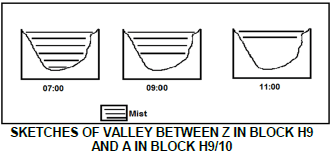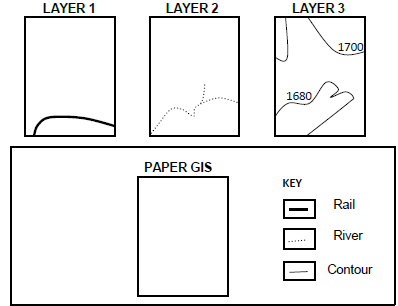GEOGRAPHY PAPER 2 GRADE 12 QUESTIONS - NSC PAST PAPERS AND MEMOS NOVEMBER 2016
Share via Whatsapp Join our WhatsApp Group Join our Telegram GroupGEOGRAPHY PAPER 2
GRADE 12
NATIONAL SENIOR CERTIFICATE
NOVEMBER 2016
RESOURCE MATERIAL
- An extract from topographical map 2729BD VOLKSRUST.
- Orthophoto map 2729 BD 13 VOLKSRUST
- NOTE: The resource material must be collected by schools for their own use.
INSTRUCTIONS AND INFORMATION
- Write your EXAMINATION NUMBER and CENTRE NUMBER in the spaces on the cover page.
- Answer ALL the questions in the spaces provided in this question paper.
- You are provided with a 1 : 50 000 topographical map (2729BD VOLKSRUST) and an orthophoto map (2729 BD 13 VOLKSRUST) of a part of the mapped area.
- You must hand the topographical map and the orthophoto map to the invigilator at the end of this examination session.
- You may use the blank page at the end of this question paper for all rough work and calculations. Do NOT detach this page from the question paper.
- Show ALL calculations and formulae, where applicable. Marks will be allocated for these.
- Indicate the unit of measurement in the final answer of calculations.
- You may use a non-programmable calculator.
- The area demarcated in RED on the topographical map represents the area covered by the orthophoto map.
- The following English terms and their Afrikaans translations are shown on the topographical map:
ENGLISH AFRIKAANS
Aerodrome Vliegveld
Diggings Uitgrawings
Furrow Voor
Golf Course Gholfbaan
Rifle Range Skietbaan
River Rivier
Sawmills Saagmeule
Sewerage Works Rioolwerke
Silos Graansuiers
GENERAL INFORMATION ON VOLKSRUST Volksrust is a town in Mpumalanga on the border of KwaZulu-Natal. It is located 240 km southeast of Johannesburg. The town has important beef, dairy, maize, sorghum, wool and sunflower seed industries. Volksrust has an average annual rainfall of 648 mm, with the lowest rainfall (1 mm) in July and the highest rainfall (117 mm) in January. Most of the rain falls in the summer. The average midday temperatures for Volksrust range from 15,9 °C in June to 24,3 °C in January. June is the coldest period when the mercury can drop to an average of 0,5 °C during the night.
|
QUESTION 1: MULTIPLE-CHOICE QUESTIONS
The questions below are based on the 1 : 50 000 topographical map (2729BD VOLKSRUST) as well as the orthophoto map of a part of the mapped area. Various options are provided as possible answers to the following questions. Choose the answer and write only the letter (A–D) in the block next to each question.
1.1 The map index/reference of the orthophoto map to the south of Volksrust is …
- 2729 BD 18 in Mpumalanga.
- 2729 BD 18 in KwaZulu-Natal.
- 2729 BD 8 in Mpumalanga.
- 2729 BD 8 in KwaZulu-Natal.
1.2 The true bearing of 2 in the centre of the sewerage works from trigonometrical station 152 at point 1 on the orthophoto map is …
- 127°
- 242°
- 50°
- 66°
1.3 The feature causing environmental problems at 3 on the orthophoto map:
- Agriculture
- River erosion
- Excavations
- Industrialisation
1.4 The feature at 4 on the orthophoto map is a/an …
- rugby field.
- tennis court.
- purification plant.
- open parking area.
1.5 The stream order of the river at K in block A6 on the topographical map is …
- 1
- 2
- 3
- 4
1.6 If you follow the N11 in a southerly direction, you will cross the provincial border into …
- KwaZulu-Natal.
- Limpopo.
- Gauteng.
- the Free State.
1.7 The stream pattern that dominates the area covered by blocks A9/10 and B9/10 is …
- centripetal.
- radial.
- rectangular.
- trellis.
1.8 The dominant street pattern at L in blocks D3/4 on the topographical map is a … pattern.
- radial
- unplanned irregular
- gridiron
- planned irregular
1.9 The type of farming at 27°24'30''S 29°53'30''E / 27°24,5'S 29°53,5'E is ... farming.
- plantation
- crop
- dairy
- fruit
1.10 The slope from spot height 1606, M in block I6, to N in block I7 on the topographical map is a … slope.
- convex
- terrace
- gentle
- concave
1.11 The fluvial landform at Y in block F6 is an indication that … has taken place.
- river grading
- rejuvenation
- deposition
- lateral erosion
1.12 A factor responsible for the location of the industrial area at O in block D4 on the topographical map is …
- raw material.
- climate.
- transport.
- stable ground.
1.13 The land-use zone in block D2 on the topographical map in which Jubapark is situated, is known as the …
- zone of decay.
- commercial zone.
- industrial zone.
- rural-urban fringe.
1.14 Which natural feature assists in purifying the water before it reaches the dam in block D9?
- Cultivated lands
- Marsh and vlei
- Trees
- Flat land
1.15 Volksrust is an example of a … town.
- mining
- bridge
- gap/gateway
- recreational
(15 x 1) [15]
QUESTION 2: MAP CALCULATIONS AND TECHNIQUES
2.1 The magnetic bearing between two points on the topographical map was 326°37' for the year 2010.
2.1.1 Will the magnetic bearing for 2016 between the same two points be larger or smaller?
_____________________________________________________
(1 x 1) (1)
2.1.2 Give a reason for your answer to QUESTION 2.1.1.
_____________________________________________________
_____________________________________________________
_____________________________________________________
(1 x 1) (1)
2.2 Calculate the area of the cultivated lands, area P in block F4 on the topographical map, in km². Show ALL calculations. Marks will be awarded for calculations. Clearly indicate the unit of measurement in your answer.
Formula: area = length (L) × breadth (B)
______________________________________________________________
______________________________________________________________
______________________________________________________________
______________________________________________________________
______________________________________________________________
______________________________________________________________
______________________________________________________________
______________________________________________________________
______________________________________________________________
(5 x 1) (5)
2.3 Two gradients, 1 : 24 and 1 : 58, represent slopes 5 and 6 respectively on the orthophoto map.
2.3.1 Match the gradients 1 : 24 and 1 : 58 with slopes 5 and 6 on the orthophoto map.
Slope 5: ______________________________________________
Slope 6: ______________________________________________
(2 x 1) (2)
2.3.2
Which ONE of the two gradients, 1 : 24 or 1 : 58, is the steeper?
____________________________________________________
(1 x 1) (1)
Interpret the ratio of the gradient selected in QUESTION 2.3.2(a).
____________________________________________________
____________________________________________________ (1 x 1) (1)
2.4 Refer to the cross-section from Q in block E7 to R in block D9 on the topographical map.
2.4.1 Indicate the following features on the cross-section using the key indicated in brackets next to the feature:
- Δ235 (T)
- Secondary road (S)
- Marsh and vlei (M) (3 x 1) (3)

2.4.2 Give ONE reason why a person standing at Q will NOT be visible to a person standing at R.
_____________________________________________________
_____________________________________________________
(1 x 1) (1)
2.4.3
Vertical exaggeration (VE) is calculated to indicate relief differences of a cross-section.
Give the vertical scale of the cross-section as a ratio scale.
________________________________________________
(1 x 1) (1)
Determine the vertical exaggeration (VE) of the cross-section. Show ALL calculations. Marks will be awarded for calculations.
Formula: vertical exaggeration= vertical scale
horizontal scale
________________________________________________
________________________________________________
________________________________________________
________________________________________________
________________________________________________
________________________________________________
(4 x 1) (4)
[20]
QUESTION 3: APPLICATION AND INTERPRETATION
3.1 Refer to the valley between spot height 1709 in block H9 and trigonometrical station 241 in block G10 on the topographical map.
3.1.1 Why did the farmer select site V to grow his/her crops?
______________________________________________________
(1 x 1) (1)
3.1.2 Crops are stored in local silos. Is this a primary, secondary or tertiary activity?
_____________________________________________________
(1 x 1) (1)
3.1.3 The suitability of site V for cultivation may be reduced by flooding. Explain this statement.
_____________________________________________________
_____________________________________________________
(1 x 2) (2)
3.1.4 The farmer at V noticed that early morning mist in winter starts to clear from the bottom of the valley, as indicated in the sketches below. Explain why this happens.

_____________________________________________________
______________________________________________________
______________________________________________________
______________________________________________________
______________________________________________________
(2 x 2) (4)
3.2 Refer to the perennial stream in block B10 and state the general direction in which this perennial stream flows. Give TWO reasons for your answer.
Direction:
_____________________________________________________
Reasons:
_____________________________________________________
_____________________________________________________
_____________________________________________________
(1 + 2) (3)
3.3 Compare the settlements marked S in block B7 and T in block J3, using the criteria below. Complete the table.
3.3.1
| S | T | |
| Settlement pattern | ||
| Dominating type of primary activity in the area |
(4 x 1) (4)
3.3.2 Give TWO points of evidence on the topographical map that suggests that the primary activity at T is practised extensively.
_____________________________________________________
_____________________________________________________
(2 x 1) (2)
3.4 Refer to blocks F3 and G3.
3.4.1
Give the general shape of the built-up areas Charlestown and Clavis.
________________________________________________
(1 x 1) (1)
Give ONE reason for this general shape.
________________________________________________
________________________________________________
(1 x 1) (1)
3.4.2 State ONE factor that could have influenced the location of Charlestown and Clavis.
_____________________________________________________
(1 x 2) (2)
3.5 Volksrust serves as a central place town to the surrounding rural areas.
3.5.1 Give ONE point of evidence on the topographical map that indicates that Volksrust is a central place town.
_____________________________________________________
_____________________________________________________
(1 x 1) (1)
3.5.2 How may the many roads passing through Volksrust impact on the sphere of influence of the town?
_____________________________________________________
(1 x 1) (1)
3.5.3 Explain your answer to QUESTION 3.5.2.
_____________________________________________________
_____________________________________________________
_____________________________________________________
(1 x 2) (2)
[25]
QUESTION 4: GEOGRAPHICAL INFORMATION SYSTEMS (GIS)
4.1
Refer to the orthophoto map and answer the questions that follow.
4.1.1 Define the term database.
_____________________________________________________
_____________________________________________________
(1 x 1) (1)
4.1.2 An urban and regional planner wants to examine the building density of Volksrust. He/She decides to use an orthophoto map in the local council's database. Give TWO reasons for his/her choice.
_____________________________________________________
_____________________________________________________
_____________________________________________________
_____________________________________________________
(2 x 2) (4)
4.2 Refer to block B5, which consists of a number of data layers.
4.2.1 Use the THREE data layers below to create a paper GIS in the block provided.

(3 x 1) (3)
4.2.2 Which GIS process was used to produce the paper GIS in QUESTION 4.2.1?
_____________________________________________________
(1 x 1) (1)
4.2.3 Which data storage method (vector or raster) did you use to create the paper GIS in QUESTION 4.2.1? Give ONE reason for your answer.
Storage method:
_____________________________________
Reason:
_____________________________________
_____________________________________
(1 + 2) (3)
4.2.4 Use the letter A to indicate the most suitable site for a heavy industrial area on the paper GIS in the block (QUESTION 4.2.1). Give a reason for your choice of site.
Site in block:
Indicate the site on the paper GIS block (QUESTION 4.2.1).
Reason:_____________________________________
_____________________________________
(1 + 2) (3)
[15]
TOTAL: 75
